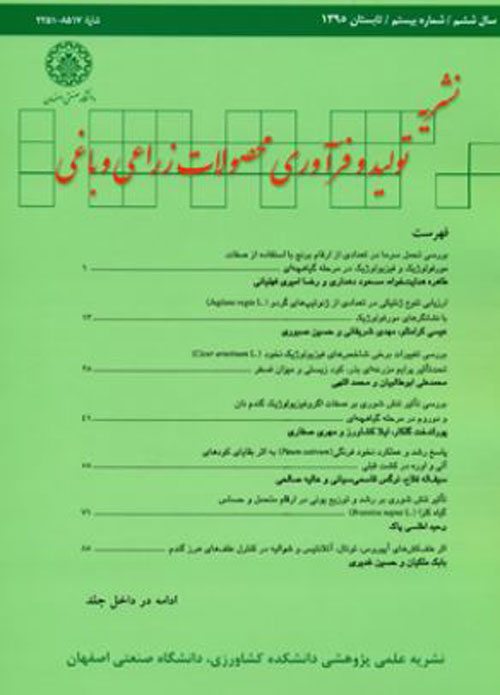Evaluation of Some Physiological and Grain Yield Responses of Chickpea (Cicer arietinum L.) Cultivars to Irrigation Regimes and Salinity
Author(s):
Abstract:
In order to investigate some physiological responses and grain yield of five chickpea cultivars under different levels of moisture and salinity, two experiments (i.e. a pot and a field experiment) were conducted in 2012. In the pot experiment, effects of four salt levels (i.e. control, 50, 75 and 100 mM of NaCl) on five chickpea cultivars, i.e. Arman, Azad, Hashem, ILC-482 and Noorabad were studied in a 3-replicate factorial completely random design experiment. In the field experiment, responses of the latter cultivars to four moisture regimes (i.e. no irrigation, irrigation after 75, 100 and 150 mm of evaporation) based on evaporation from a Class-A Standard Pan were evaluated in a 3-replicate split-plot randomized complete block experiment. Data obtained from the pot experiment indicated that proline accumulation, Na concentration and Naﲯ were increased, but K concentration, relative water content and plant dry mass were decreased with increase in salt level. Since cultivar ILC-482 tended to indicate a greater proline concentration, in contrary to a smaller Na concentration and plant dry mass, compared to the remaining cultivars, it seemed to be more tolerant to the salinity. Data from the field experiment confirmed that delayed irrigation leads to increase in proline accumulation and decreases in leaf area index, plant dry mass and grain yield. Irrigating chickpea after 75, 100 and 150 mm evaporation resulted in 1964, 1675 and 1503 kg/ha of grain yield, leading to 114%, 84% and 64% increases in grain yield, respectively, compared to the no irrigation control. Cultivars Noorabad and Hashem produced the greatest (i.e. 1610 kg/ha) and smallest (i.e. 1361 kg/ha) grain yields, respectively. According to the findings of this one-year field study, seeding cultivar Noorabad concomitant to irrigation after 150 mm evaporation could, perhaps, lead to a substantial increase in grain yield in Noorabad region of the Lorestan Province in Iran. Though, cultivar ILC482 tended to indicate a more stable plant dry mass, when subjected to different irrigation regimes and different levels of saline water.
Keywords:
Language:
Persian
Published:
Journal of Crop production and processing, Volume:6 Issue: 1, 2016
Pages:
69 to 84
magiran.com/p1534261
دانلود و مطالعه متن این مقاله با یکی از روشهای زیر امکان پذیر است:
اشتراک شخصی
با عضویت و پرداخت آنلاین حق اشتراک یکساله به مبلغ 1,390,000ريال میتوانید 70 عنوان مطلب دانلود کنید!
اشتراک سازمانی
به کتابخانه دانشگاه یا محل کار خود پیشنهاد کنید تا اشتراک سازمانی این پایگاه را برای دسترسی نامحدود همه کاربران به متن مطالب تهیه نمایند!
توجه!
- حق عضویت دریافتی صرف حمایت از نشریات عضو و نگهداری، تکمیل و توسعه مگیران میشود.
- پرداخت حق اشتراک و دانلود مقالات اجازه بازنشر آن در سایر رسانههای چاپی و دیجیتال را به کاربر نمیدهد.
In order to view content subscription is required
Personal subscription
Subscribe magiran.com for 70 € euros via PayPal and download 70 articles during a year.
Organization subscription
Please contact us to subscribe your university or library for unlimited access!




